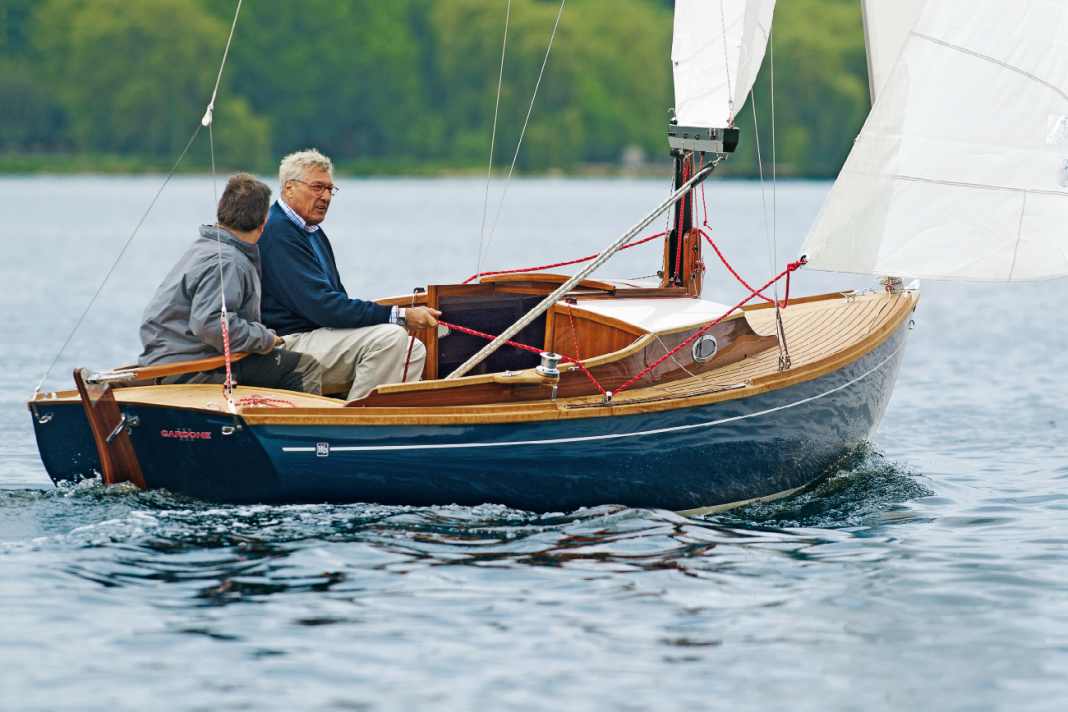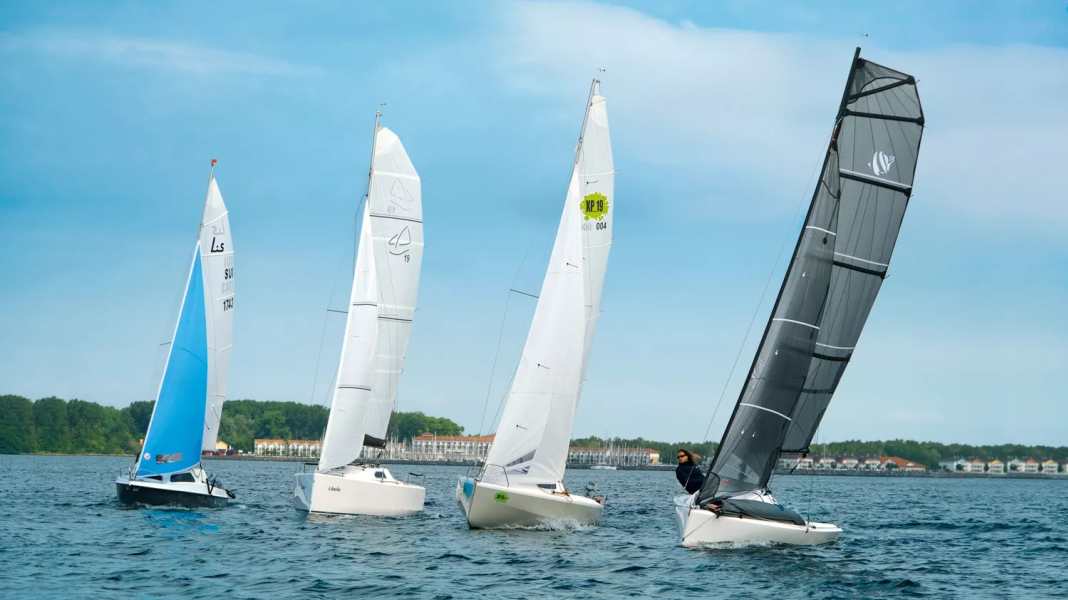
In this test report:
- Presentation of the four small cruisers
- The small cruisers individually under sail
- Key figures and measured values
- Direct comparison of the small cruisers under sail
- Variable draught, with the small cruisers to the beach
- Living on the small cruisers
- The construction method
- The prices at a glance
- Prices and data in detail
- Market overview of small cruisers
- The video of the test
The 19-foot hull length segment offers an exciting mix of dinghy and small cruiser. The boats can be easily trailered, allowing a flexible choice of sailing area, and road transport is also exciting in terms of price, as the costs for winter storage and mooring can be eliminated if you have your own parking space. The boats are ready to sail very quickly and are easy to manoeuvre without an engine or single-handed. They can also reach the beach thanks to variable draughts. Although the cabin offers hardly any comfort, it is sufficient for stretching out and spending the night. The boats therefore offer rudimentary living comfort, but leave much larger yachts behind when under sail, at the latest when they start planing, and offer simple sailing fun. Depending on their use, they can best be characterised as daysailers, touring dinghies, small cruisers or micro cruisers.
The size of the boat is not new, but it has many useful advantages: You can explore inland and coastal areas on your doorstep, but also further afield. This is practical in times when moorings are in short supply. If you do need a permanent berth, it is easier and cheaper to find one with a small boat. On some inland waterways, these are also limited in size. If the boat is used more for an after-work trip, the daysailer will be ready more quickly.
A small electric outboard motor is sufficient as an auxiliary drive, but it is also possible without one, as the boats can be manoeuvred in confined spaces even under sail, just like a dinghy. Last but not least, the lower purchase price compared to large cruising yachts makes the small cruisers extremely attractive. Not only new models were tested, but also sailing boats that are currently available on the market, even if the designs are older.
Presentation of the four small cruisers
Beneteau First 18: Racer from Slovenia
Four boats came to Boltenhagen to the Yachtwelt Weiße Wiek for the comparison test: The Beneteau First 18 has been built by Seascape in Slovenia since 2010 and has been offered unchanged as the First 18 SE since the takeover by the French shipyard. And that's a good thing, because the standardised class is actively used for regattas. The small cruiser is kept very simple and straightforward, and has a high speed potential, especially when sailing downwind with a gennaker. But it's not just regatta sailors who will have fun with the small First, as the boat is also ideal for an afternoon cruise or even a trip lasting several days. Gennaker manoeuvres are made easy thanks to the mountain trumpet. In northern Germany, the boat is sold by Oleu Watersports in Heiligenhafen - which is where our test boat came from. Enjoy Yachting in Seelze near Hanover is also a Beneteau dealer.
Lis 6.0: Evergreen from Germany
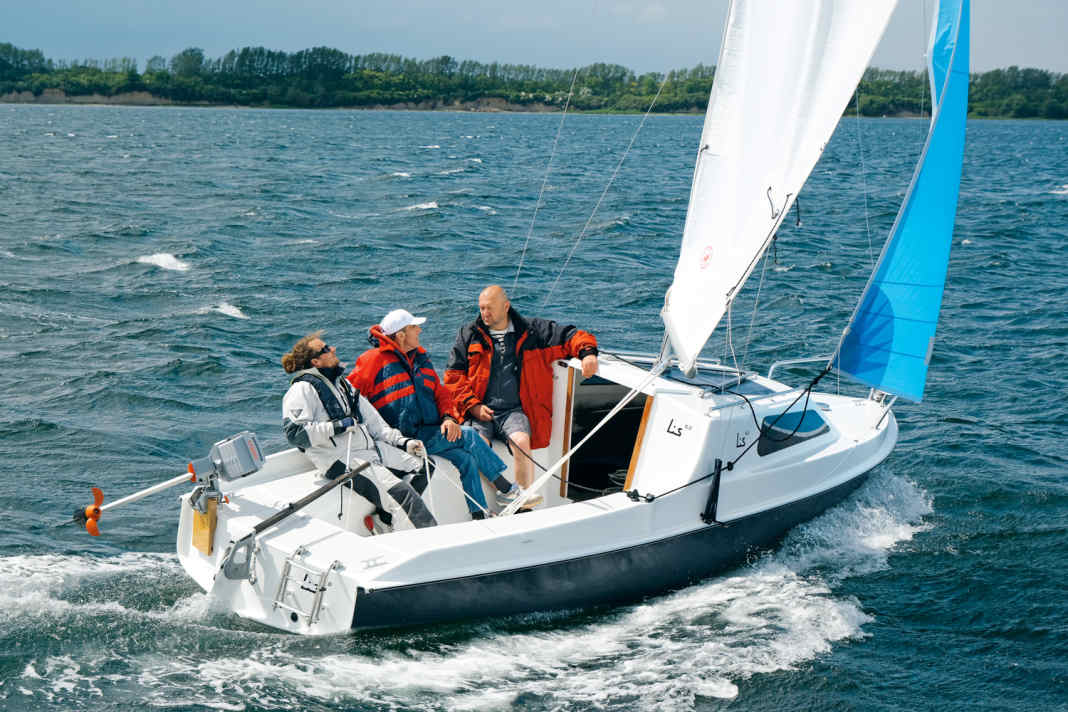





The Lis 6.0 has been built by Gade Bootsbau since 2016 and was designed as a further development of the Lis dinghy to mark the company's 50th anniversary. The Lis is available in three versions: as a dinghy with only a small storage space in the foredeck and as a Lis dinghy cruiser with a slip cabin. In the Lis family, the hull was widened and raised slightly to increase the interior space. The boats were sold very successfully over five decades, with around 1,600 being built. The Lis 6.0 has been further developed from the proven design. The hull has been made one metre longer and the cockpit and superstructure have also been redesigned. This version has not yet been tested by YACHT. At 420 kilograms, the Lis 6.0 is the lightest and most attractively priced boat in the test field.
Sailart 19: Daysailer from German-Polish Coop
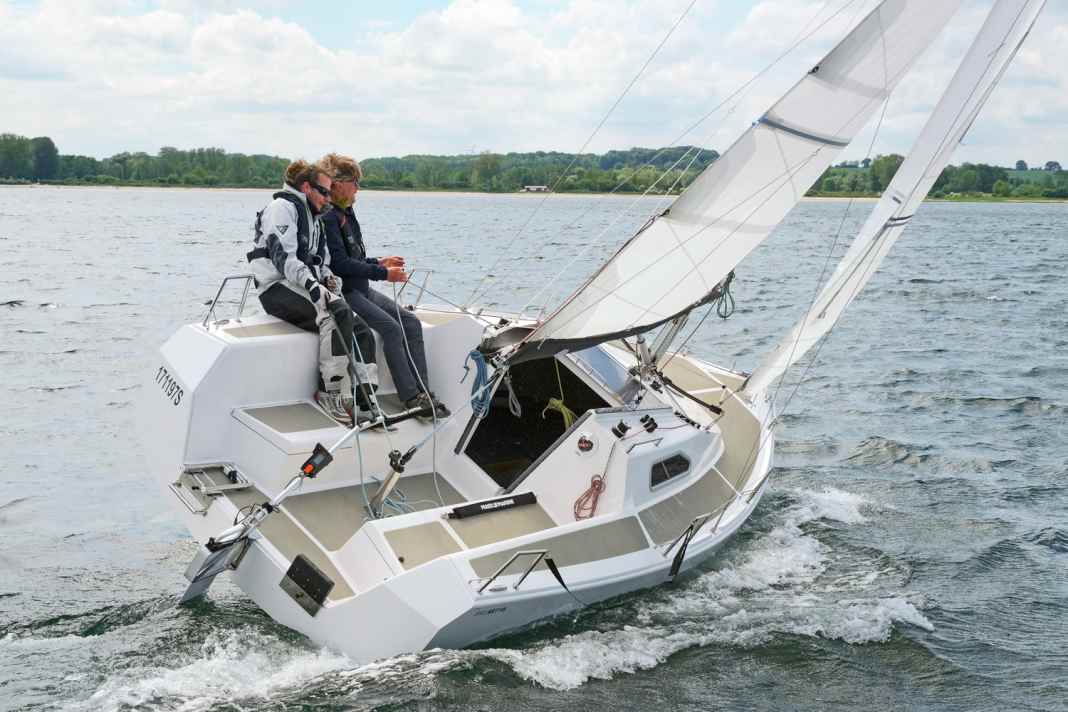





The Sailart 19 has been around since 2016, it was created as a supplement to the Sailart 20 and is intended to appeal to an audience that sails fewer tours but undertakes shorter day trips. The shipyard in Erftstadt has the hulls manufactured in Poland and is known for its high quality standards and successful detail solutions. The 19 is the boat with the largest interior space in the test field, but also the widest and heaviest boat in the comparison.
The XP 19: Single-handed, from Slovenia
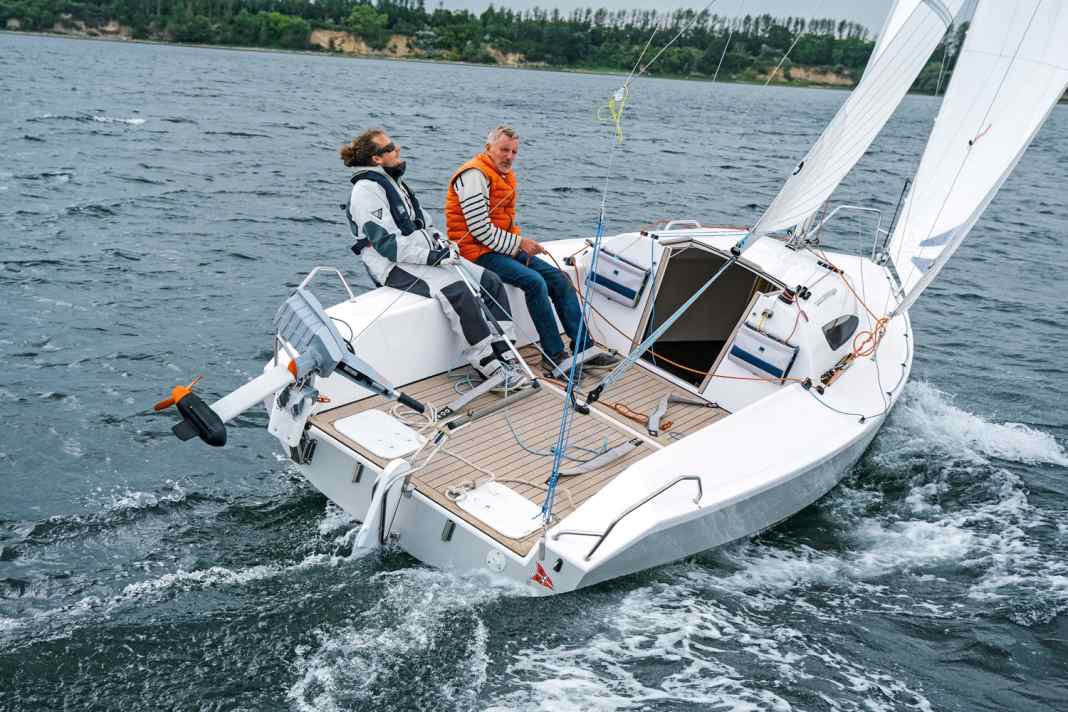





The XP 19 is the latest design (2020). It is the project of Andreas Budde, an enthusiastic microtonnage sailor, and is optimised for single-handed sailing. That is why the gennaker is not actually intended. The almost neutral, less swept-back spreaders are intended to maintain the mainsail profile even in room winds and be less affected by shrouds and spreaders. The XP needs a backstay for this. She is built in Slovenia.
Key figures and measured values
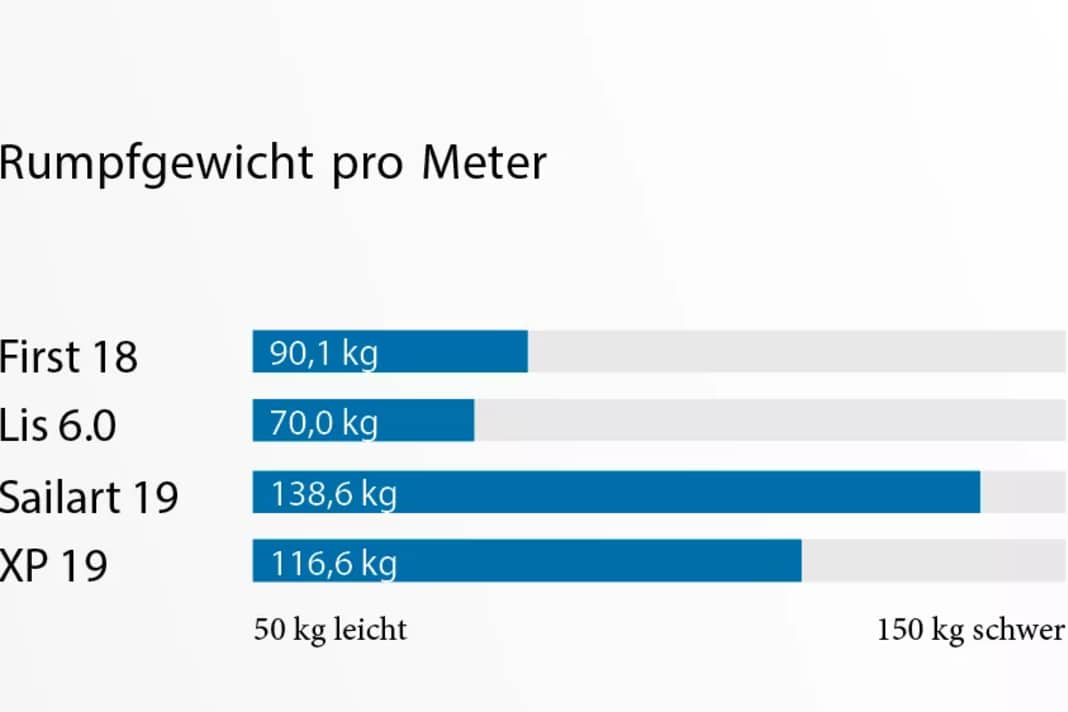



The small cruisers individually under sail
Excellent test conditions were offered over three days. Starting from the Yachtwelt Weiße Wiek, the test strokes led out onto the Wohlenberger Wiek at the entrance to Wismar Bay. With plenty of wind of twelve knots, gusting up to 23 knots on the first day of the test, the candidates had to prove their seaworthiness. They benefited from the fact that no large waves built up in the test area with south-westerly winds. Nevertheless, the day was challenging for boats and crews.
Lis 6.0: Weaknesses on the upwind course
Lis 6.0 in particular struggled at first. The genoa halyard could not be properly enforced at first. As the controls are located on the forestay, it is difficult to solve the problem at sea with a flapping headsail. When furled, the trim device is covered by the furled sail. After a short pit stop in the harbour, the problem was at least partially resolved. Overall, the forestay still had a lot of slack and the headsail had a very bulbous profile. This created a lot of pressure, which paradoxically even increased due to the first reef in the main. The provisionally shorn-in reefing line created an extreme belly in the sail, so that the pressure actually decreased after the sail was hoisted out with a full main. Without the backstay, however, the forestay could only be tensioned insufficiently. This should actually be possible thanks to the swept spreaders, but the shrouds, which were quite thin at four millimetres, also gave way somewhat, so the rig was quite wobbly.
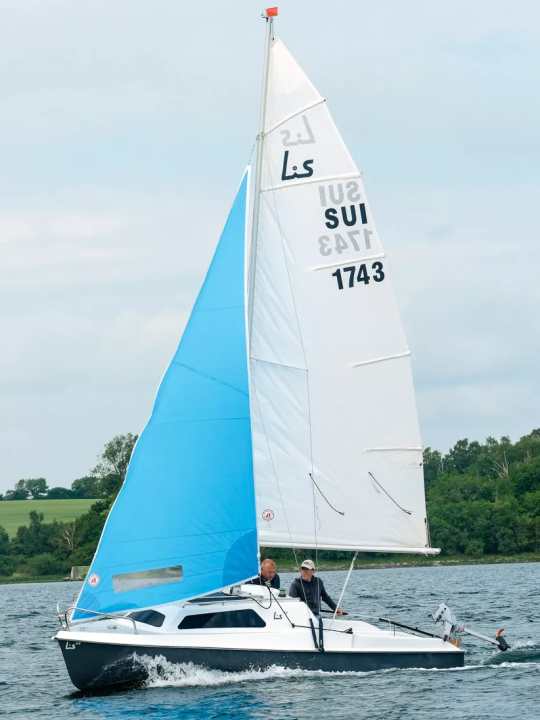
With a third man in the cockpit, the Lis 6.0 could then be controlled, but it was not possible to get very high into the wind. In strong gusts, the mainsheet had to be generously feathered to maintain control. The downhaul on the rudder blade had so much stretch that the blade folded slightly aft at speed. As a result, the rudder pressure increased enormously with increasing speed. As a result, the small cruiser had problems travelling through the wind in strong gusts. It was therefore necessary to drop a little and pick up more speed. This made it all the more astonishing that the boat, which weighed just 420 kilograms, suddenly logged 9.8 knots of speed over the ground in a gust. The wake tore off cleanly, and spray sprayed upwards on both sides of the bow. However, the lightweight construction was also evident when the feet were propped up against the opposite cockpit bulwark: the material flexed slightly.
Beneteau First 18: plenty of sailing fun
The Lis 6.0 was not the only boat that was able to planing that day. Without exception, all the test boats were able to do this, even without a gennaker. Only the First 18 was equipped with a space wind sail. This is an option on all boats. On the First, the gusts didn't feel like a fight for survival; single-handed, it was clearly overpowered, but remained manageable; with two people, with a little more weight on the edge, it was really fun. The Fathead mainsail has the advantage that it is cut very flat - this is possible because the air flows around it efficiently even in the upper third. It provides plenty of propulsion without high pressure. In strong gusts, it is sufficient to ease the mainsheet slightly, then the profile in the upper section pushes to windward and thus generates a righting moment. This keeps the boat fast and easy to handle with just two people, even at high wind speeds on upwind courses. The twin rudder system provides good feedback and steers sensitively.
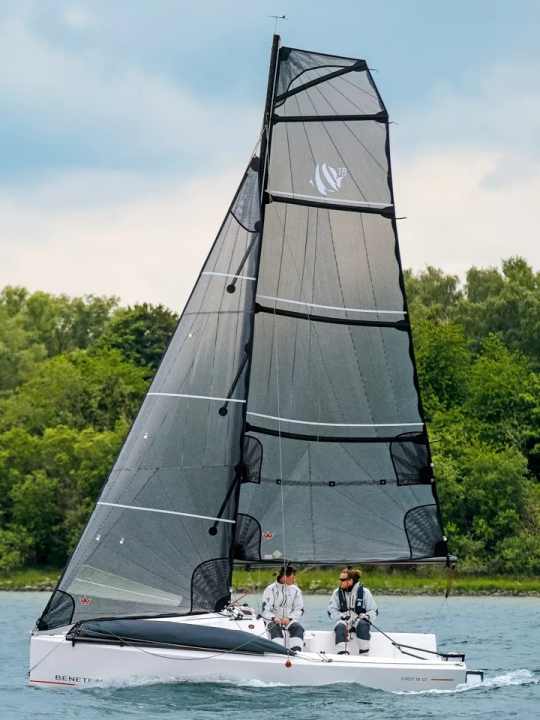
It stays that way when the gennaker goes up. The colourful sail is tucked away in the trumpet on the foredeck, the sail neck is attached to the nock of the retractable gennaker pole. This means that only the boom needs to be extended, there is no tack line. The gennaker halyard is endless and becomes a recovery line when recovering the space windsail, with which the cloth is pulled back into the trumpet. This makes it very easy to operate. On the evening of the first test day, the wind had already dropped slightly, the gusts no longer reached the 20-knot mark, but with the gennaker the First 18 repeatedly logged twelve knots of speed over the ground. As long as the space wind sail was set, the boat remained planing.
XP 19: agile with plenty of sail area
The XP 19 also travelled at over ten knots, but without a gennaker. In the sometimes strong gusts, the ship glided well and logged around eight knots. With the help of the stern wave of the photo boat in combination with a gust of a good 20 knots, the log briefly showed 11.2 knots, but then the rudder blade broke off at waterline level. The breaking edge started right at the hole on the leading edge of the blade where the downhaul line attaches - the hole may have weakened the structure at this point. Fortunately, the XP 19 was manoeuvrable without a rudder thanks to the electric outboard and was able to sail into the harbour on its own. A replacement rudder blade from the next build number could be fitted the very next day.
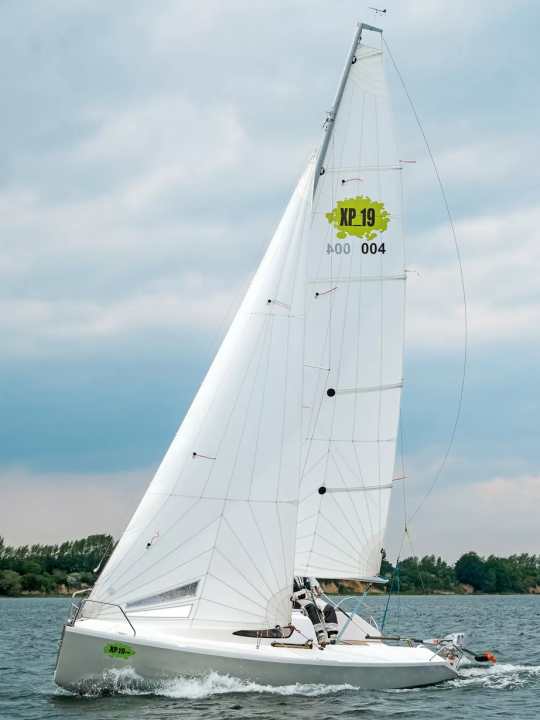
In the windy conditions of the first test day, the XP 19 was easy to sail with two people, but there was a lack of weight upwind and active trimming of the mainsheet was essential. Alone, the boat could only be controlled with a mainsail and furled headsail. The high sail carrying capacity of the XP 19 shows it: a lot of sail area for the weight of the boat. However, the standard version includes a smaller mainsail for strong winds. It was noticeable that the hoisting points for the genoa are positioned on the outside of the superstructure, which means that less narrow sheet angles are possible compared to the ridge and the sail type. When fully furled, the genoa hit the upper shrouds.
Sailart 19: a small performance cruiser
The Sailart 19 sailed most confidently single-handed, even in windy conditions. This is certainly due to the high dimensional stability due to the width and the high ballast ratio. The self-tacking jib also made manoeuvres very easy. The width, weight and smaller headsail are certainly an advantage in more windy conditions, but did not mean a disadvantage in terms of speed.
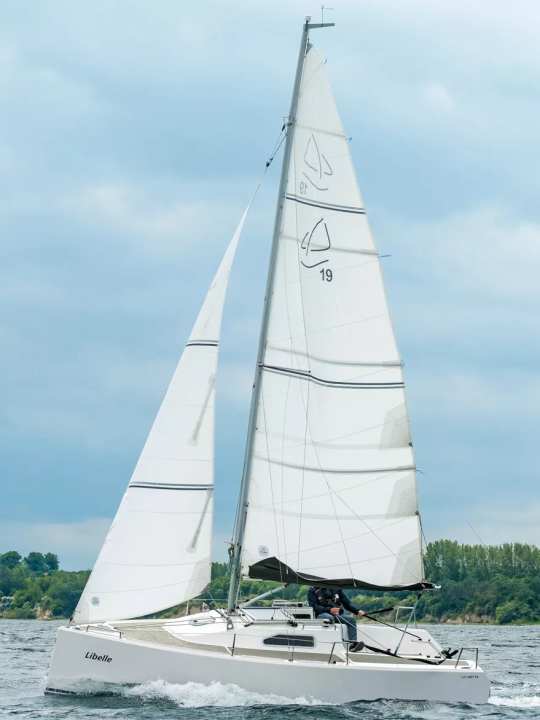
The boat glided well even without a gennaker and was fun to sail and safe in equal measure. The steering is direct and the cockpit offers good seating positions. In windy conditions, the best place to sit is on the top edge. The railing is made of webbing instead of wire. These seem very loose at first, but make it much easier to ride out and contribute to a very comfortable sitting position, while at the same time optimising the body weight upwind.
Direct comparison of the small cruisers under sail
On the following days, the performance in medium and light winds could also be compared. In very light wind conditions, all the boats in the test group sailed like dinghies. In ten to twelve knots of wind with light gusts, all candidates logged between 4.5 and just under six knots of speed over ground at around 60 degrees to the true wind. First was the fastest, closely followed by Sailart and XP, while Lis was able to keep up surprisingly well. This is certainly due to the low overall weight, but the advantage is relativised by the smallest sail area in the comparison.
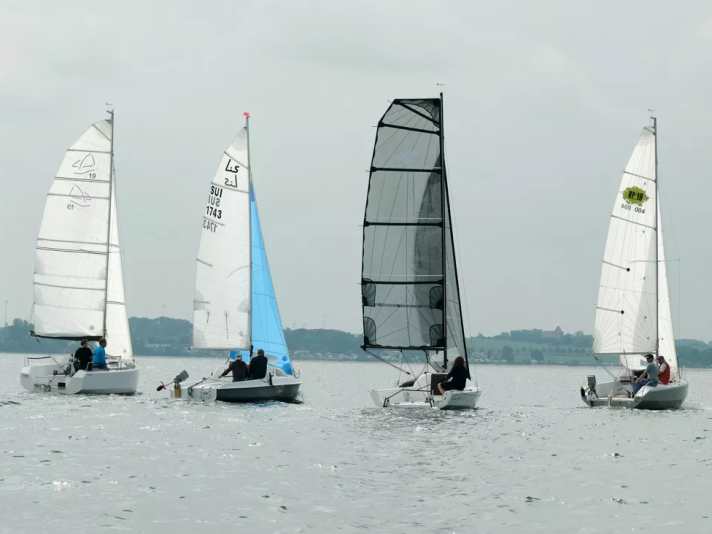
In light winds below ten knots, the Sailart's performance was closer to that of the First 18, which can be explained by the narrower waterline. The Sailart only fully utilises its righting moment when the chine is in the water. The ridge, on the other hand, needs a bit of leeway on the wind, then less lateral surface is wetted and the boat sails faster. The Lis 6.0 could no longer keep up in very light winds. In very light breezes, the weight advantage did not help her, here the quality of the sails and their surface area have more influence.
Variable draught, with the small cruisers to the beach
We took the test group to the beach to test the great advantage of the lifting keel in addition to the ease of trailering. With the exception of the Sailart, which had a 60 centimetre draught with the keel raised, all of them made it to the shore. As a regatta boat, the First was the least prepared for such a manoeuvre. For example, there are no rubber bands on the rudder blades to enable them to be raised and locked continuously. It is only intended to be completely in the water or out. However, without a rudder and with the keel raised, the boat starts to drift very quickly, and even a very light breeze in the rig and on the hull is enough. It therefore requires a little dexterity and a jump into chest-high water to get to the beach without running aground with the blades. As they are guided in a cassette, they cannot fold aft when running aground and damage is therefore likely.
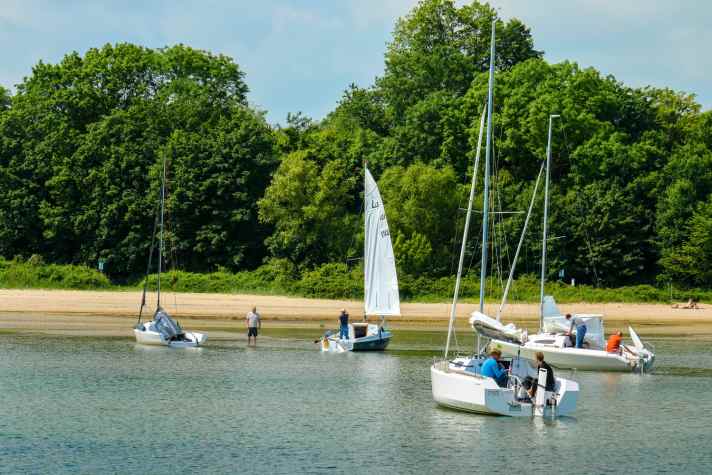
This is not the case with Lis, XP and Sailart, where the blades, once unlocked, simply lay backwards in case of grounding. With the XP 19, however, it should be noted that the keel does not fold and must therefore be caught up early to avoid damage.
Living on the small cruisers
Ridge 18: sufficient lying surface
Once a nice spot has been found on the beach or in the shallow water in front of it, the question of the small cruiser's habitability immediately arises. As the sportiest boat, the First 18 also offers the least living comfort. At least there is a 2.00 by 1.60 metre sunbathing area in the bow; cushions are available as an option (667 euros). But it is not easy to get into the cabin from the companionway, the entrance is very narrow and the winch for the keel is in the way. There are no superstructure windows below deck, it looks like a cave.
Lis 6.0: King-size berth
This looks much better on the Lis 6.0. The step below deck is also somewhat cramped due to the companionway, but then there is a very cosy little cabin. Thanks to a strong structure in the ceiling, the compression pressure of the mast is channelled into the hull without any support. This provides more space. At 2.37 x 1.80 metres, the berth is already king size; it only reaches these dimensions when the table and an additional cushion add the foot space between the thwarts to the sleeping area. A textile covering on the side walls and a special coating on the cabin ceiling ensure a cosy atmosphere, regulating the indoor climate and preventing condensation.
Sailart 19: full-grown small cruiser
Below deck on the Sailart 19 it feels like being on a full-grown small cruiser. This shows that the shipyard has developed a proper spatial concept. This is evident in the good seating options, a practical storage solution, cosy lighting and wooden elements that create a ship-like atmosphere. The berth in the bow measures 1.98 metres in length and width, and 44 centimetres at the foot end. Then there are the benches, which measure 2.24 metres by 0.67 metres.
XP 19: large cockpit, suitable for a cake stand
The XP 19, on the other hand, does not offer as much comfort below deck as the Sailart. Cushions are also optionally available here. There is also room for two people to stretch out, but this is somewhat divided by the lifting keel. This means that the head and upper body have to lie on the bench seat, and the bunk in the foredeck is only around 1.60 metres long. With the exception of the ridge, all three test candidates have windows in the superstructure. The XP also has a very spacious cockpit (1.30 by 2.55 metres). This can quickly be converted into additional living space with the help of a tarpaulin.
The construction method
There are some differences in construction between the test boats. The deck and hull of the First 18 and Sailart 19 are made from a sandwich laminate of glass fibre and polyester resin with a foam core. On the First, vinylester resin was used for the first layers. On the XP 19, the deck is also a sandwich with a foam core, while the hull is a full laminate. Sailart and XP have an inner shell in addition to the sandwich deck. It ensures a clean finish and the additional insulation prevents condensation in the interior.
The deck and hull of the Lis 6.0 are made from a full laminate. The finish below deck looks a little rough in places, the mineral coating to prevent condensation is rough. Fittings on deck are visible on the inside. Peter Gade, head of the Gade Kunststofftechnik shipyard, explains that 200 hours must be enough to complete a build. Otherwise the boat is no longer profitable due to the higher labour costs in Germany.
In comparison, the XP 19 requires a great many hours of labour for the deck-hull connection alone. This is laminated to the upper part of the side wall with an additional insert. Many hours are spent filling and sanding. 600 in total.
The prices at a glance
Despite these differences, the ships are priced closely together. The standard price of the Lis is lower, but the XP already includes more as standard. With the equipment in the test, the XP 19 was the cheapest at 28,000 euros, closely followed by the Lis at 29,000 euros. The XP 19 came without upholstery, in which case the boats are on a par in terms of price. The Beneteau First 18 costs around 35,000 euros in the equipment version. This includes a complete gennaker set-up and high-quality sail set. The Sailart 19 would have cost 41,000 euros. This includes a customised Torqeedo with steering on the tiller and battery in the forecastle box as well as electrical installation below deck. The ready-to-sail price also includes the trailer.
But which boat is the right one? If you want to go fast and enjoy racing, the First 18 is the best choice. The Sailart 19 offers the best compromise between living comfort and sailing performance. With a special trailer, it can also be slipped normally. Lis 6.0 and XP 19 are the most attractive in terms of price, but the XP 19 has the edge with the best mix of price and performance. And once planing, all candidates are faster than some 35-foot yachts.
Prices and data in detail
First 18
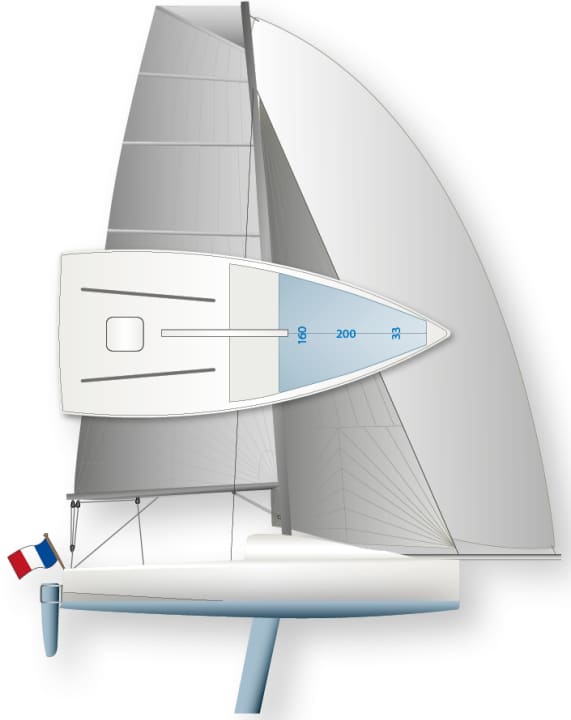
Design engineer Manuard YD/EP Studio
Technical data
- CE design category C
- Hull length 5.55 m
- Waterline length 5.45 m
- Width 2.38 m
- Draught 0.18-1.50 m
- Mast height above WL 8.52 m
- Theoretical hull speed 6.0 knots
- Weight 500 kg
- Ballast/proportion 125 kg/25 %
- Mainsail 15,60 m2
- Furling genoa (106 %) 9.00 m2
- Gennaker (option) 35,00 m2
Hull and deck constructionBoth polyester sandwich with honeycomb core material
Equipment and prices
- Base price ex shipyard € 31,059
- Price ready to sail € 40,063
Shipyard Beneteau/Seascape
Distribution Oleu Watersports, Jachthafen-Promenade, 23774 Heiligenhafen
Lis 6.0
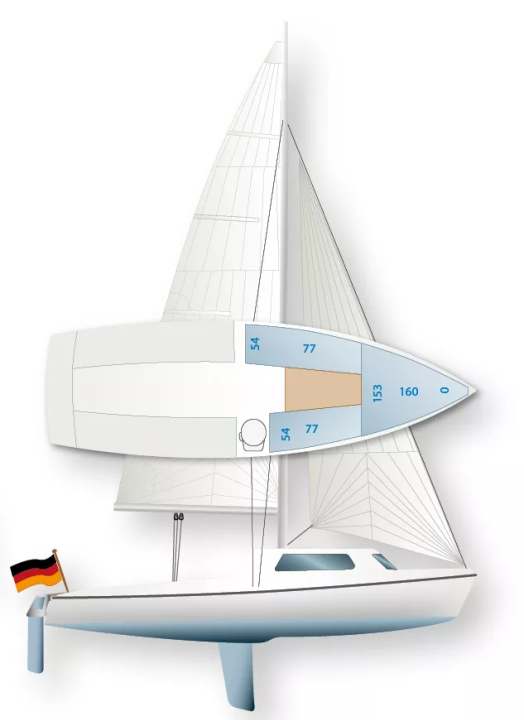
Design engineer Dieter Gade
Technical data
- CE design category C
- Hull length 6.00 m
- Waterline length 5.60 m
- Width 2.08 m
- Draught 0.25-1.25 m
- Mast height above WL 8.20 m
- Theoretical hull speed 5.6 knots
- Weight 420 kg
- Ballast/proportion 80 kg/19 %
- Mainsail 11,00 m2
- Furling genoa (106 %) 7.00 m2
- Spinnaker (option) 15,00 m2
Hull and deck constructionBoth polyester full laminate in hand rest
Equipment and prices
- Base price ex shipyard € 20,490
- Price ready to sail 29.935 €
Shipyard and distribution Peter Gade Kunststofftechnik, Eilendorfer Straße 153, 52078 Aachen, Germany
Sailart 19

Design engineer Sailart
Technical data
- CE design category C
- Hull length 5.70 m
- Waterline length 5.40 m
- Width 2.50 m
- Draught/alternative 0.60-1.30 m
- Mast height above WL 9.10 m
- Theoretical hull speed 5.5 knots
- Weight 790 kg
- Ballast/proportion 180 kg/23 %
- Mainsail 14,00 m2
- Self-tacking jib 6.00 m2
- Gennaker (option) 25,00 m2
Hull and deck constructionBoth polyester sandwich with Divinycell core
Equipment and prices
- Base price ex shipyard € 35,600
- Price ready to sail € 46,814
Shipyard and distribution Sailart, Siemensstraße 8a, 50374 Erftstadt
XP 19

Design engineer Andreas Budde
Technical data
- CE design category C
- Hull length 6.00 m
- Waterline length 5.18 m
- Width 2.44 m
- Draught/alternative 0.35-1.25 m
- Mast height above WL 8.60 m
- Theoretical hull speed 5.52 knots
- Weight 700 kg
- Ballast/proportion 90 kg/3 %
- Mainsail 11.50 m2
- Furling genoa (106 %) 8.00 m2
- Gennaker (option) 26,00 m2
Hull and deck constructionHull: polyester full laminate, deck: sandwich with foam core
Equipment and prices
- Base price ex shipyard € 28,000
- Price ready to sail 34.150 €
Shipyard and distribution Germanboats, Kloppstockstraße 8, 33613 Bielefeld
Market overview of small cruisers
There are other boats in similar dimensions. From retro classics to trimarans, everything is included. A selection
